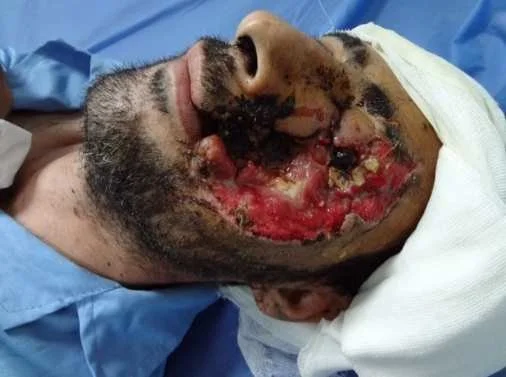Imagine losing the skin and soft tissue from your face in one traumatic incident. A degloved face is a truly devastating injury that drastically alters one’s appearance and can be a challenging condition to manage.
So, what does degloved face look like? It’s a term used to describe the event where the skin and underlying soft tissues are stripped away from the facial bones, leaving the muscles and bones exposed. The affected individual may not have any facial features, leaving a gruesome sight that is often difficult to look at.
In this article, we’ll explore degloved face in detail, including its causes, effects, treatments, rehabilitation, and psychological impact on the individual.
Causes and Effects of Degloved Face

A degloved face is a traumatic injury that occurs when the skin and soft tissue of the face become separated from the underlying muscles and bones. This type of injury is often caused by motor vehicle accidents, falls, or workplace accidents where the face is forcefully crushed or sheared against a hard surface. While rare, animal bites and severe burns can also cause a degloved face.
The effects of a degloved face can be severe and long-lasting, impacting the individual physically, emotionally, and socially. The injury can cause extensive damage to the facial tissues, including skin loss, muscle and nerve damage, and potential bone fractures. The severity of the injury can lead to disfigurement, loss of function, and chronic pain.
The psychological effects of a degloved face can be just as debilitating, with individuals often experiencing depression, anxiety, and post-traumatic stress disorder (PTSD) as they adjust to their new appearance and lifestyle. The injury can also affect an individual’s ability to communicate and interact with others, leading to social isolation and difficulties with relationships.
Causes of a Degloved Face
A degloved face is typically caused by a traumatic event that involves a significant amount of force being applied to the face. Some common causes include:
- Motor vehicle accidents, particularly those involving motorcycles
- Falls from a height, such as from a ladder or scaffolding
- Workplace accidents, such as being caught in machinery or struck by heavy equipment
- Animal bites or severe burns
Effects of a Degloved Face
The effects of a degloved face can be devastating, both physically and emotionally. Some common effects include:
- Loss of skin and soft tissue, exposing muscles and bones
- Muscle and nerve damage that can affect facial expression, speech, and swallowing
- Bone fractures and displacement, often requiring surgical intervention
- Disfigurement and scarring that can impact self-esteem and confidence
- Chronic pain and discomfort
Overall, the effects of a degloved face can greatly impact an individual’s quality of life, making it important to seek immediate medical attention and ongoing support.
The Physical Changes: A Closer Look at Degloved Face

A degloved face is a severe and traumatic injury that causes significant physical changes to the affected area. The injury typically occurs when the skin and soft tissues of the face are forcibly separated from the underlying bone and muscles, resulting in the loss of tissue and exposure of underlying structures.
As a result of the injury, the affected area may appear distorted and disfigured, with exposed muscles, tendons, and bones visible. The severity of the physical changes will depend on the extent of tissue loss and the location of the injury.
| Physical Changes | Description |
|---|---|
| Skin Loss | The skin may be completely or partially detached, exposing underlying tissue and structures. This can lead to infection and other complications. |
| Exposed Muscles | Muscles and tendons may be visible and protrude from the skin. This can result in limited mobility, pain, and difficulty performing basic functions such as speaking, eating, and drinking. |
| Bone Fractures | If the injury involves facial bones, fractures may occur and require surgical intervention to repair. The injury may also affect the eyes and vision. |
Overall, the physical changes resulting from a degloved face can have a significant impact on the affected individual’s quality of life, affecting both their physical and emotional well-being.
Treatment Options and Rehabilitation for Degloved Face

After a degloved face injury, treatment is imperative to ensure proper healing of the damage. The approach taken will depend on the severity of the injury, the extent of the damage, and the patient’s individual needs.
Surgical Interventions
In cases where the degloved face injury has resulted in severe damage to the soft tissue and bones, surgery may be necessary. This may include procedures to repair or replace damaged skin, reattach underlying muscles and tendons, and reconstruct facial bones if necessary.
Reconstructive surgery is performed by a plastic surgeon with specialized training in facial reconstruction. The procedure may involve the use of skin grafts or flaps, which are taken from other areas of the patient’s body and used to replace damaged skin and tissue.
Ongoing Rehabilitation
After surgery, ongoing rehabilitation is necessary to help restore function and aesthetics to the affected area. The use of physical therapy, occupational therapy, and speech therapy may be necessary to help the patient regain full movement, sensation, and control of their facial muscles.
Psychological Support
A degloved face injury can have a significant impact on an individual’s mental health and emotional well-being. Support groups, counseling, and other available resources can be a valuable tool for those struggling to cope with the psychological effects of their injury.
It is essential to provide the patient with a comprehensive support system to aid in their recovery. This can include family and friends, as well as medical professionals trained in treating traumatic injuries.
Coping with a Degloved Face: Psychological Impact and Support

Dealing with a degloved face can be a traumatic and emotionally challenging experience. The psychological impact of such an injury can be significant, affecting not only the individual but also their support system. Patients may experience feelings of shame, embarrassment, anxiety, depression, and anger, leading to a decline in self-esteem and quality of life.
The Psychological Impact of a Degloved Face
The psychological impact of a degloved face can be substantial. Patients may feel self-conscious or anxious about their appearance and social interactions. They may avoid social situations, leading to feelings of isolation and loneliness. Furthermore, the trauma of the injury can trigger post-traumatic stress disorder (PTSD) and other mental health disorders.
It is important to recognize that individuals with a degloved face require both physical and psychological support. Proper care must be taken to address the emotional aspects of the injury to aid in the healing process.
Available Support and Resources
There are many resources available to help individuals cope with the psychological impact of a degloved face. Support groups, counseling, and therapy can provide a safe space to discuss emotions, concerns, and fears related to the injury. Many rehabilitation centers also offer psychological support in addition to medical and surgical care.
Family and friends can also play an essential role in providing emotional support to individuals with a degloved face. They can help create a positive and accepting environment, offer practical assistance, and serve as a source of motivation and reassurance.
Furthermore, it is crucial to seek out organizations that provide practical and emotional support for individuals with facial disfigurement. These groups can provide valuable information, resources, and a network of people who understand and relate to the challenges faced by people with a degloved face.
FAQs
- How does degloved face happen?
Degloved face happens when the skin is torn away from the underlying tissue, usually on the face. This can be caused by a variety of things, such as industrial accidents, motor vehicle accidents, falls, animal attacks, or other accidents.
- Can you fix a degloved face?
Yes, a degloved face can be fixed, but the extent of the damage will determine the success of the treatment. In some cases, the degloved skin can be reattached, but more often, skin grafts or flaps from other parts of the body are needed to cover the exposed flesh. Reconstructive surgery may be required, and the recovery process can be long and difficult.
- How painful is degloved face?
The pain of a degloved face can be excruciating, especially if the injury is severe. The exposed nerves and tissues are very sensitive, and any movement can cause pain. Pain medication is usually prescribed to help manage the pain.
- Can people survive face degloving?
Yes, people can survive face degloving. However, the severity of the injury will determine the chances of survival. In cases where the degloving is extensive, the person may suffer from significant blood loss or other complications that could lead to death.
- Can skin grow back after degloving?
Yes, skin can grow back after degloving. However, the amount of skin that grows back will depend on the severity of the injury. In cases where the degloving is extensive, the person may have permanent scarring.
- Can a human survive being skinned alive?
It is unlikely that a human could survive being skinned alive. The pain would be excruciating, and the person would likely bleed to death.
- Can degloving heal on its own?
Degloving cannot heal on its own. Medical treatment is required to repair the damage.
- Is degloved face scary?
Yes, degloved face can be scary. The sight of exposed flesh and bone can be very disturbing.
- What happens after degloving?
After degloving, the person will need to undergo a series of medical procedures to repair the damage. These procedures may include skin grafts, flaps, and reconstructive surgery.
- How long can we live without skin?
We cannot live without skin for very long. Skin protects us from the elements, helps regulate our body temperature, and prevents infection. Without skin, we would be very vulnerable to injury and disease.
- What would happen if you had no skin?
If you had no skin, you would be very susceptible to infection and injury. You would also be unable to regulate your body temperature, which could lead to hypothermia or hyperthermia.
- Has a human ever been skinned?
Yes, there have been cases of humans being skinned. In some cases, this was done as a form of torture or execution. In other cases, it was done as a medical procedure.
